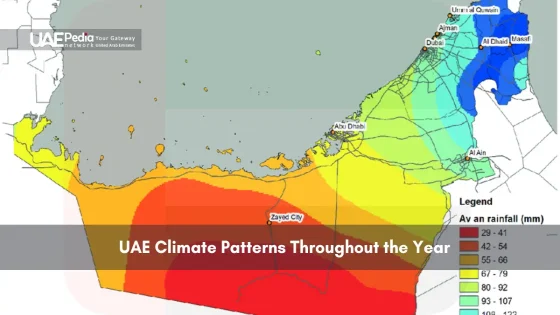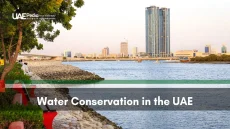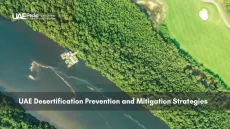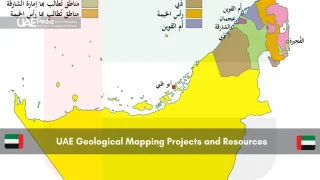In a country where desert sands meet skyscrapers, the United Arab Emirates now faces its most daring transformation yet. While it ranks among the top 10 global producers of crude oil, recent data reveals a surprising shift: renewable energy capacity has tripled since 2015, with solar parks now powering entire neighborhoods.
The nation’s Energy Strategy 2050 charts an ambitious course – aiming for 75% clean power generation within 26 years. Updated emission inventories show a 15% downward revision in historical totals, proving progress isn’t just theoretical. But how does this translate for residents watching solar panels rise beside oil derricks?
Three elements make this transition unique. First, the strategy directly addresses high per capita energy use through smart grids and efficiency mandates. Second, it leverages oil wealth to fund AED 200 billion green infrastructure projects. Third, carbon capture systems aim to neutralize emissions from unavoidable fossil fuel use.
- The UAE plans to cut CO₂ output by 18% before 2030 while growing its economy
- Solar capacity targets now exceed 5,000MW – enough to power 1.3 million homes
- Updated climate data shows faster progress than international observers initially reported
Understanding the UAE Carbon Footprint Landscape
Imagine a climate dashboard where oil-rich sands meet solar innovation. Over two decades, emission patterns here have shifted like desert winds—peaking in the 2010s before recent corrections. Updated inventories reveal a 15% drop in past estimates, thanks to sharper tracking of industrial leaks and energy waste.
From Skyline to Spreadsheet: Tracking Progress
Interactive charts show fascinating details. A resident today contributes 17 metric tons of CO₂ yearly—down 22% since 2015 but still triple the global average. Why? The answer lies in two measurement methods. Production-based counts (local factories, power plants) dominate reports, while consumption-based math (imported goods, travel habits) tells a fuller story.
Seeing Through the Data Lens
Three sectors drive most greenhouse gas emissions here: energy production (58%), manufacturing (23%), and transportation (12%). Yet renewables now offset 8% of annual totals—a figure climbing faster than Dubai’s Burj Khalifa once did. As one analyst put it: “You can’t shrink what you don’t measure—and this nation measures with satellite precision.”
- Energy sector emissions fell 9% since 2020 despite population growth
- Methane leaks from infrastructure dropped 34% through better monitoring
- Interactive tools let you compare annual totals against 200+ countries
Sustainable Strategies and Energy Transitions in the UAE
Picture solar panels stretching across sun-baked horizons while cranes erect new eco-friendly cities. This nation’s energy playbook blends bold bets on renewables with pragmatic steps to manage existing systems. Let’s unpack how this balancing act works.
Sun-Powered Dreams Meet Grid Realities
The country aims to source 30% of its electricity from clean sources by 2030—triple today’s share. A $54 billion renewables push fuels projects like the Al Dhafra Solar Park, which alone powers 160,000 homes. But here’s the twist: fossil fuel infrastructure still expands, creating what analysts call “parallel energy universes.”
| Initiative | Progress | Impact |
|---|---|---|
| Solar Capacity | 5,000MW achieved | Cuts 2.4M tons CO₂/year |
| Nuclear Plants | 1 operational | 25% future grid share |
| Energy Efficiency | 40% reduction goal | Saves $3B annually |
The Carbon Capture Tightrope
Carbon capture systems promise to trap emissions from factories and power plants. While pilot projects show promise, scaling up faces hurdles. Storing CO₂ underground requires specific geology—something this desert landscape lacks in many areas. Costs also remain steep: $60-80 per ton versus $20 for solar investments.
- Renewables get 85% of climate funding, CCS just 8%
- Current capture capacity handles under 5% of annual emissions
- New membrane tech could slash CCS costs by 2030
Walking this energy tightrope isn’t easy. But as one engineer told us: “We’re building the plane while flying it—messy, but thrilling to watch.”
Policy Plans and National Commitments Driving Change
Think of national climate plans as evolving blueprints – constantly revised as new data arrives. Recent inventory updates reveal a 15% drop in historical emissions totals. This isn’t magic math, but sharper tracking of industrial leaks and energy waste. Now, the real work begins: closing the 29-74 million ton gap between current policies and 2030 targets.
The Roadmap Reality Check
Six sectors hold the keys to success. Power generation leads with a 45% emissions cut target by 2030, while transport aims for 28% reductions through electric vehicle incentives. Buildings face strict efficiency codes, and industry must adopt carbon capture systems. But here’s the catch: current measures only cover 60% of needed reductions.
| Sector | 2030 Target | Policy Gap |
|---|---|---|
| Energy Production | -45% | 19 MtCO₂e |
| Manufacturing | -22% | 34 MtCO₂e |
| Transport | -28% | 11 MtCO₂e |
Tech Promises vs. Implementation Speed
Carbon capture systems get lots of buzz, but current capacity handles under 5% of annual emissions. Renewables receive 85% of climate funding, while CCS struggles with costs and geological limitations. As one planner told us: “We’re racing to scale solutions that don’t yet exist at commercial levels – it’s like building an airplane mid-flight.”
Transparency remains key. Updated inventories now track 97% of greenhouse gas sources versus 82% in 2020. This clearer picture helps prioritize efforts, but global comparisons show the country still ranks 25th in per capita emissions worldwide. Progress? Visible. Mission accomplished? Not yet.
Case Study: UAE Carbon Footprint – Initiatives and Impact
Imagine standing at a crossroads where desert heat meets global climate grids. Interactive charts reveal this nation’s emissions sit at 0.5% of worldwide totals—comparable to Spain’s output but with 1/5th the population. Here’s where numbers get intriguing: each resident here generates 17 tons of CO₂ yearly, triple Germany’s rate but half America’s.
Measuring Against the World’s Yardstick
Three insights emerge when comparing data dashboards. First, cumulative emissions since 1990 total 3.4 billion tons—equivalent to 1.2% of global historical output. Second, renewable energy growth outpaces oil-rich peers like Saudi Arabia by 38%. Third, methane reductions here beat 87% of countries analyzed.
| Country | Per Capita CO₂ | Total Emissions Share |
|---|---|---|
| United States | 15.5 tons | 13.5% |
| Germany | 8.4 tons | 2.1% |
| UAE | 17.1 tons | 0.5% |
| India | 1.9 tons | 7.3% |
Color-coded maps show progress: emissions per dollar of GDP dropped 21% since 2015—faster than 74% of nations. But peer comparisons reveal gaps. While solar capacity grows quickly, heating/cooling systems still guzzle 40% more energy than EU averages.
Analysts highlight two lessons from global leaders. Norway’s electric vehicle incentives (79% market share) prove faster transitions are possible. Denmark’s wind-powered grids (50% renewable) show how small nations can punch above their weight. As one climate scientist noted: “Progress isn’t about being perfect—it’s about moving faster than yesterday.”
- Interactive tools let you drag timelines to see how policies shift rankings
- Waste-to-energy plants now divert 76% of trash from landfills—topping regional peers
- Building codes cut energy use by 32% since 2010, matching South Korea’s pace
Forward-Looking Perspectives on a Sustainable UAE Future
Envision a horizon where innovation meets tradition under the Arabian sun—a blueprint for tomorrow taking shape today. The nation’s roadmap pairs sprawling solar farms with smart cities, aiming to slash emissions by 40% this decade while boosting economic vitality. Think floating wind turbines near coastal trade routes and AI-optimized power grids—projects turning bold visions into measurable progress.
Three game-changers stand out. Next-gen carbon capture tech could trap CO₂ at half today’s costs by 2035. Green hydrogen hubs may soon fuel planes and factories. Updated policies now link industrial permits to emission cuts, rewarding cleaner production methods. As one planner shared: “We’re not just reducing outputs—we’re redesigning how growth happens.”
The numbers tell a hopeful story. Renewable energy capacity is set to quintuple by 2040, with storage solutions overcoming desert dust challenges. Manufacturing plans show emissions falling 32% despite output growth—proving climate action and commerce can coexist. Even oil fields are evolving, testing geothermal systems that repurpose old wells.
Join us in watching this thrilling transformation unfold. Ancient trade routes could become clean energy highways, where camels walk past solar-paneled oases. The journey won’t be smooth—CCS scaling and cooling demand remain hurdles—but the pioneering spirit that built skyscrapers from sands now fuels greener ambitions. Ready to see what’s next?
The Emirates’ per capita emissions rank among the highest worldwide due to energy-intensive industries and air conditioning needs—but solar investments and efficiency programs aim to balance growth with responsibility. Think of it like turning down a thermostat while building new green cities!
Abu Dhabi’s Al Dhafra Solar Park—the world’s largest single-site plant—and Dubai’s Mohammed bin Rashid Al Maktoum Solar Park lead the charge. Add wind farms in Hatta and Barakah’s nuclear power, and you’ve got a clean energy cocktail shaking up old fossil fuel habits.
It’s a tightrope walk. While hydrocarbons fuel the economy, profits now fund green transitions—like ADNOC’s carbon capture networks and Masdar’s global renewables. Imagine using today’s energy wealth to build tomorrow’s post-oil toolkit.
The UAE publishes detailed reports through MOCCAE and participates in global platforms like UNFCCC—think of it as a climate progress report card. Updates on methane leaks or industrial CO2 get clearer each year, though challenges remain in tracking informal sectors.
Pilot sites in Al Reyadah and Ruwais test CCS in arid conditions—like storing emissions under salt caverns instead of lush forests. It’s tricky (sand isn’t great at trapping CO2), but blue hydrogen projects and mineral carbonation research might crack the code.
From smart meters cutting home energy use to Dubai Metro avoiding car trips, small shifts add up. Even choosing local veggies over imported ones or saying “naam” to reusable bags at Carrefour makes a difference—team effort, habibi!


















